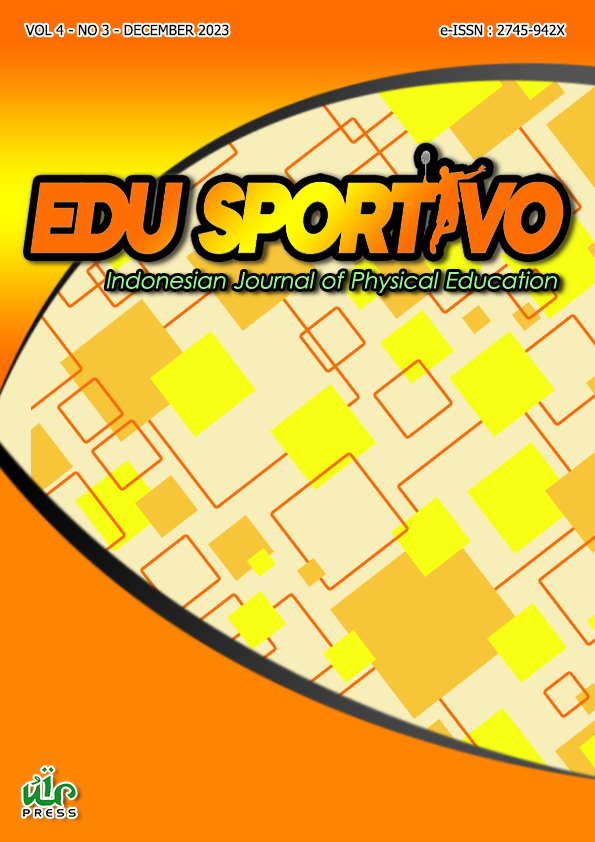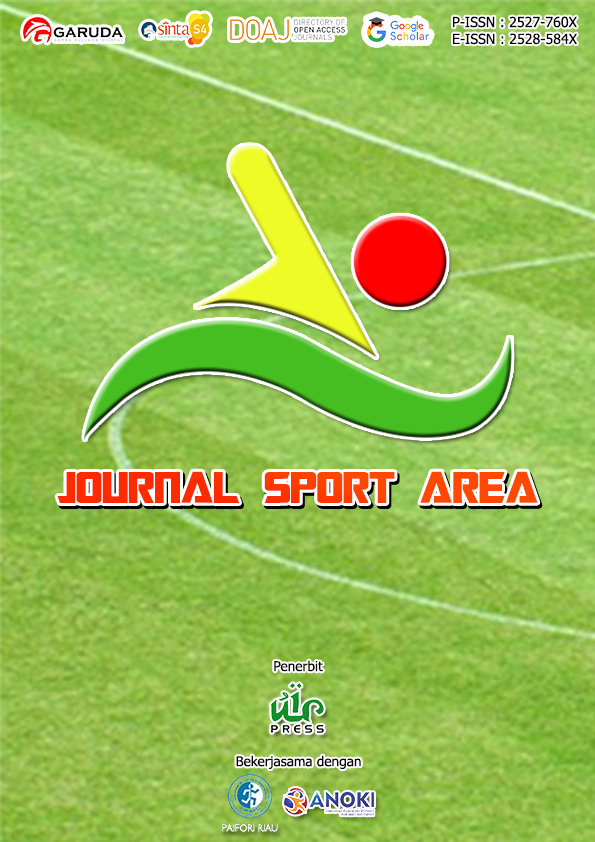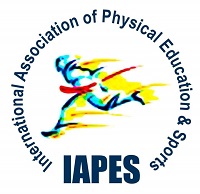Circuit-based basic motor activity games: An innovative solution to improve the movement skills of children with dyspraxia in the context of physical education
Keywords:
Motor activity, fundamental motor skills, circuit games, motor skills, dyspraxia childAbstract
Dyspraxia in children is not a hindrance in training motor skills. The purpose of this study was to analyze the effect of gaming circuit-based interventions on their motor skills. This research method used one group experimental design with pretest-posttest design. The population of the study subjects were students with dyspraxia, with a sample consisting of seven purposively selected students. The instrument used was a series of four-pole games designed to measure students’ motor skills. The research procedure began by pretesting the students’ motor skills before the intervention. Then, a game circuit-based intervention was performed on all students over a period of time. After the intervention was completed, a posttest was performed to re-measure the students’ motor skills. Data from pretest and posttest were analyzed using SPSS statistical software version 23 to compare scores before and after the intervention. These findings provide positive support to the use of a game-based approach in improving the gross motor skills of children with dyspraxia in the context of physical education. The positive implication of this study is that the circuit game approach can enrich educational interventions for children with dyspraxia and provide better insight into the development of motor skills in this population through innovative approaches. It is recommended that further research focus on specific elements of circuit play that are most effective in improving gross motor skills in children with dyspraxia, with the potential to form better guidelines in physical education.
Downloads
References
Adhariah, I. (2018). Pengaruh Permainan Tradisional terhadap Peningkatan Kebugaran Jasmani Siswa. Ibtida’i : Jurnal Kependidikan Dasar, 5(2), 273-281. https://doi.org/10.32678/ibtidai.v5i02.1392
Ahmad, N. Y. (2022). Pengaruh Permainan Tradisional Engklek Terhadap Keterampilan Gerak Lompat pada Siswa TKQ Baiturrahman Medan. Jurnal Kesehatan dan Olahraga, 5(2), 12-21. https://doi.org/10.24114/ko.v5i2.29451
Aliriad, H., Priadana, B., & Kurniawan, W. (2023a). Development of Kickboxing Tool Media for Pencak Silat Athletes. Journal Coaching Education Sport, 4(1), 95–104. https://doi.org/10.31599/jces.v4i1.185
Aliriad, H., Soegiyanto, Setijono, H., & Sulaiman. (2023b). The Effect of Project-Based on Fundamental Motor Skills to Enhance Early Children. Health Education and Health Promotion, 11(1), 125–131. https://doi.org/10.58209/hehp.11.1.125
Allen, M. (2017). The SAGE Encyclopedia of Communication Research Methods. SAGE Publications, Inc. https://doi.org/10.4135/9781483381411
Anderson-Mooney, A. J., Schmitt, F. A., Head, E., Lott, I. T., & Heilman, K. M. (2016). Gait Dyspraxia as a Clinical Marker of Cognitive Decline in Down Syndrome: a Review of Theory and Proposed Mechanisms. Brain and Cognition, 104, 48–57. https://doi.org/10.1016/j.bandc.2016.02.007
Ardiyanto, A., & Sukoco, P. (2014). Pengembangan Model Pembelajaran Berbasis Permainan Tradisional untuk meningkatkan Kemampuan Motorik Kasar Anak Tunagrahita Ringan. Jurnal Keolahragaan, 2(2), 119–129. https://doi.org/10.21831/jk.v2i2.2608
Avila-Pesantez, D., Vaca-Cardenas, L., Rivera, L. A., Zuniga, L., & Miriam Avila, L. (2018). ATHYNOS: Helping Children with Dyspraxia Through an Augmented Reality Serious Game. 2018 5th International Conference on EDemocracy and EGovernment, ICEDEG 2018, 286–290. https://doi.org/10.1109/ICEDEG.2018.8372351
Bakhtiar, S. (2014). Fundamental Motor Skill among 6-Year-Old Children in Padang, West Sumatera, Indonesia. Asian Social Science, 10(5), 155–158. https://doi.org/10.5539/ass.v10n5p155
Brantasari, M., & Aslindah, A. (2018). Implementasi Permainan menangkap Bola pada Kelenturan dan Koordinasi Otot Jari dan Tangan Anak Usia 2 - 3 Tahun. Jurnal Warna : Pendidikan dan Pembelajaran Anak Usia Dini, 1(1), 50–60. https://doi.org/10.24903/jw.v1i1.176
Carballo-Fazanes, A., Díaz-Pereira, M. P., Fernández-Villarino, M. A., Abelairas-Gómez, C., & Rey, E. (2023). Physical Activity in Kindergarten, Fundamental Movement Skills, and Screen Time in Spanish Preschool Children. Psychology in the Schools, 60(9), 3318–3328. https://doi.org/10.1002/pits.22925
Castaño, P. R. L., Suárez, D. P. M., González, E. R., Robledo-Castro, C., Hederich-Martínez, C., Cadena, H. P. G., Vargas, P. A. S., & Montenegro, L. C. G. (2023). Effects of Physical Exercise on Gross Motor Skills in Children with Autism Spectrum Disorder. Journal of Autism and Developmental Disorders, 1–10. https://doi.org/10.1007/s10803-023-06031-5
Christmas, J., & Van de Weyer, R. (2019). Hands on Dyspraxia: Developmental Coordination Disorder: Supporting Young People with Motor and Sensory Challenges. Routledge.
Clark, D. B., Hernández-Zavaleta, J. E., & Becker, S. (2023). Academically Meaningful Play: Designing Digital Games for the Classroom to Support Meaningful Gameplay, Meaningful Learning, and Meaningful Access. Computers & Education, 194, 104704. https://doi.org/10.1016/j.compedu.2022.104704
de Marchena, A., Zampella, C. J., Dravis, Z., Pandey, J., Mostofsky, S., & Schultz, R. T. (2023). Measuring Dyspraxia in Autism using a Five-Minute Praxis Exam. Research in Autism Spectrum Disorders, 106, 102200. https://doi.org/10.1016/j.rasd.2023.102200
Dhanalakshmi, B., Dhanagopal, R., Raguraman, D., & Thamdapani, T. (2020). Improving Cognitive Learning of Children with Dyspraxia using Selection Based Mid-Air Gestures in Athynos Game. Proceedings of the 3rd International Conference on Intelligent Sustainable Systems, ICISS 2020, 231–237. https://doi.org/10.1109/ICISS49785.2020.9316070
Edwarsyah, Hardiansyah, S., & Syampurna, H. (2017). Pengaruh Metode Pelatihan Circuit Training Terhadap Kondisi Fisik Atlet Pencak Silat Unit Kegiatan Olahraga Universitas Negeri Padang. Jurnal Penjakora, 4(1), 1–10. https://doi.org/10.23887/penjakora.v4i1.11749
Endrawan, I. B., & Aliriad, H. (2023). Problem-Based Collaborative Learning Model Improves Physical Education Learning Outcomes for Elementary School Students. MIMBAR PGSD Undiksha, 11(1), 9–17. https://doi.org/10.23887/jjpgsd.v11i1.59758
Engel, A., Hardy, L., Broderick, C., van Doorn, N., Ward, R., Kwai, N., & Parmenter, B. (2022). Effect of a Fundamental Motor Skills Intervention on Fundamental Motor Skill and Physical Activity in a Preschool Setting: A Cluster Randomized Controlled Trial. Pediatric Exercise Science, 34(2), 57–66. https://doi.org/10.1123/PES.2021-0021
Fata, N., Rustiawan, H., & Sutisna, N. (2023). Pengaruh Latihan Lempar Tangkap dan Menendang Bola Secara Langsung dan Lempar Tangkap dan Menendang Bola Secara Terpisah Terhadap Peningkatan Koordinasi Mata, Tangan, dan Kaki. Jurnal Keolahragaan, 8(2), 103-111. https://doi.org/10.25157/jkor.v8i2.9620
Frankenburg, W. K., & Dodds, J. B. (1967). The Denver Developmental Screening Test. The Journal of Pediatrics, 71(2), 181–191. https://doi.org/10.1016/S0022-3476(67)80070-2
Ginanjar, A., & Suherman, A. (2018). Improving Physical Activity of Students with Low Fundamental Movement Skills Using Sport Education Model. Proceedings 2nd International Conference on Sports Science, Health and Physical Education, 1, 280–282. https://doi.org/10.5220/0007059802800282
Hayati, F., & Julia. (2018). Peningkatan Kemampuan Interpesonal melalui Permainan Balon Berpasangan di Kelompok Bermain PAUD Bina Insani Kemala Bhayangkari 1 Banda Aceh. Buah Hati, 5(1), 63–71. https://doi.org/10.46244/buahhati.v5i1.567
Jiménez Díaz, J., Salazar Rojas, W., & Morera, M. (2015). Age and Gender Differences in Fundamental Motor Skills (Original Version in English). Pensar En Movimiento: Revista de Ciencias Del Ejercicio y La Salud, 13(2), 1–16. https://doi.org/10.15517/pensarmov.v13i2.18327
Kasih, I. (2018). Development of Learning Model Smash Volleyball Based Circuit. International Journal of Science and Research (IJSR), 7(5), 293–295. https://doi.org/10.21275/30041804
Kokstejn, J., & Musalek, M. (2019). The Relationship between Fundamental Motor Skills and Game Specific Skills in Elite Young Soccer Players. Journal of Physical Education and Sport, 19, 249–254. https://doi.org/10.7752/jpes.2019.s1037
Lee-Cultura, S., Sharma, K., & Giannakos, M. (2022). Children’s Play and Problem-Solving in Motion-Based Learning Technologies using a Multi-Modal Mixed Methods Approach. International Journal of Child-Computer Interaction, 31, 100355. https://doi.org/10.1016/j.ijcci.2021.100355
Lloyd, M., Saunders, T. J., Bremer, E., & Tremblay, M. S. (2014). Long-Term Importance of Fundamental Motor Skills: a 20-Year Follow-Up Study. Adapted Physical Activity Quarterly, 31(1), 67–78. https://doi.org/10.1123/apaq.2013-0048
Loprinzi, P. D., Cardinal, B. J., Loprinzi, K. L., & Lee, H. (2012). Benefits and Environmental Determinants of Physical Activity in Children and Adolescents. Obesity Facts, 5(4), 597–610. https://doi.org/10.1159/000342684
Lorente, L. M. (2017). Implementation of Early Childhood Physical Activity Curriculum (SPARK) in the Central Valley of California (USA). Procedia - Social and Behavioral Sciences, 237, 319–325. https://doi.org/10.1016/j.sbspro.2017.02.097
Malika, L. D., Hariadi, I., Fadhli, N. R., & Roesdiyanto, R. (2022). Keterampilan Motorik Kasar Anak Usia Prasekolah di TK Muslimat NU Dewi Masithoh 01 Kalipare Kabupaten Malang. Sport Science and Health, 4(11), 964–979. https://doi.org/10.17977/um062v4i112022p964-979
Masteller, B., & Sirard, J. R. (2019). Effects of a Teacher-led Movement-training Program on Physical Fitness, Motor Skills, and Physical Activity in Third and Fourth Grade Students. Medicine & Science in Sports & Exercise, 51(6S), 773–773. https://doi.org/10.1249/01.mss.0000562805.61017.f8
Meachon, E. J., Beitz, C., Zemp, M., Wilmut, K., & Alpers, G. W. (2022). The Adult Developmental Coordination Disorders/Dyspraxia Checklist – German: Adapted Factor Structure for the Differentiation of DCD and ADHD. Research in Developmental Disabilities, 126, 104254. https://doi.org/10.1016/j.ridd.2022.104254
Miharja, R. R. R. S., Mulyana, E. H., & Muslihin, H. Y. (2020). Peningkatan Keterampilan Motorik Halus melalui Permainan Sains Billon pada Kelompok B. Early Childhood : Jurnal Pendidikan, 4(2), 75–87. https://doi.org/10.35568/earlychildhood.v4i2.855
Miller, M., Chukoskie, L., Zinni, M., Townsend, J., & Trauner, D. (2014). Dyspraxia, Motor Function and Visual-Motor Integration in Autism. Behavioural Brain Research, 269, 95–102. https://doi.org/10.1016/j.bbr.2014.04.011
Mukherjee, S., Ting Jamie, L. C., & Fong, L. H. (2017). Fundamental Motor Skill Proficiency of 6- to 9-Year-Old Singaporean Children. Perceptual and Motor Skills, 124(3), 584–600. https://doi.org/10.1177/0031512517703005
Multahada, A., Melaty, P., Apriyani, H., & Andriani, T. (2022). Pengembangan Motorik Kasar Anak Usia Dini melalui Permainan Kreatif. PrimEarly : Jurnal Kajian Pendidikan Dasar dan Anak Usia Dini, 5(1), 11–21. https://doi.org/10.37567/prymerly.v5i1.1248
Mylsidayu, A., Tangkudung, J., & Hanif, A. S. (2020). Effectiveness of Physical Activity Circuit Model on Endurance of Elementary School Students. 1st Progress in Social Science, Humanities and Education Research Symposium (PSSHERS 2019), 205–208. https://doi.org/10.2991/assehr.k.200824.048
Ningsih, R. W., Slamet Suyanto, & Fahmi, F. (2020). A Development of Number Circuit Game Based Learning Strategy to Introduce Numeral Symbols for Children Aged 4-5 Years. Mitra Ash-Shibyan: Jurnal Pendidikan Dan Konseling, 4(01), 47–58. https://doi.org/10.46963/mash.v4i01.231
Pedro, A., Goldschmidt, T., & Daniels, L. (2019). Parent-carer awareness and understanding of dyspraxia: Implications for child development support practices. Journal of Psychology in Africa, 29(1), 87–91. https://doi.org/10.1080/14330237.2019.1568092
Permata, R. D. (2020). Pengaruh Permainan Puzzle Terhadap Kemampuan Pemecahan Masalah Anak Usia 4-5 Tahun. PINUS: Jurnal Penelitian Inovasi Pembelajaran, 5(2), 1–10. https://doi.org/10.29407/pn.v5i2.14230
Puspita, L., & Umar, M. Y. (2020). Perkembangan Motorik Kasar dan Motorik Halus Ditinjau dari Pengetahuan Ibu Tentang Pertumbuhan dan Perkembangan Anak Usia 4-5 Tahun. Wellness And Healthy Magazine, 2(1), 121–126. https://doi.org/10.30604/well.80212020
Ramadhan, N., Nurhasan, N., Indahwati, N., Baqiyudin, G., Saifuddin, H., Mustaqim, S., & Perdanawati, F. (2023). Development of Fundamental Motor Skill Activities Circuit-Based Games to Improve the Motor Skills of Children with Dyspraxia. Health Education and Health Promotion, 11(3), 1001–1012. https://doi.org/10.58209/hehp.11.3.471
Romlah, R. (2017). Pengaruh Motorik Halus dan Motorik Kasar terhadap Perkembangan Kreatifitas Anak Usia Dini. Tadris: Jurnal Keguruan dan Ilmu Tarbiyah, 2(2), 131. https://doi.org/10.24042/tadris.v2i2.2314
Satria, M. H., Aliriad, H., Kesumawati, S. A., Fahritsani, H., Endrawan, I. B., & S, A. (2023). Model Pengembangan Keterampilan Motorik My Home Environment terhadap Anak Disabilitas Intelektual. Jurnal Obsesi : Jurnal Pendidikan Anak Usia Dini, 7(2), 2336–2347. https://doi.org/10.31004/obsesi.v7i2.4415
Schwarzer, G., Jovanovic, B., Kubicek, C., & Hegele, M. (2018). Introduction: Object processing and motor development. Journal of Motor Learning and Development, 6(1), 1–5. https://doi.org/10.1123/jmld.2017-0064
Scott, M. W., Wood, G., Holmes, P. S., Williams, J., Marshall, B., & Wright, D. J. (2021). Combined Action Observation and Motor Imagery: an Intervention to Combat the Neural and Behavioural Deficits Associated with Developmental Coordination Disorder. Neuroscience & Biobehavioral Reviews, 127, 638–646. https://doi.org/10.1016/j.neubiorev.2021.05.015
Shields, N., & Synnot, A. (2016). Perceived Barriers and Facilitators to Participation in Physical Activity for Children with Disability: A Qualitative Study. BMC Pediatrics, 16(1), 1–10. https://doi.org/10.1186/s12887-016-0544-7
Sistiarini, R. D. (2021). Pengembangan Permainan Sirkuit Animove untuk Menstimulasi Kemampuan Motorik Kasar Anak Usia 5-6 Tahun. AWLADY : Jurnal Pendidikan Anak, 7(1), 46. https://doi.org/10.24235/awlady.v7i1.6837
Sugino, H., & Ushiyama, J. (2021). Gymnasts’ Ability to Modulate Sensorimotor Rhythms during Kinesthetic Motor Imagery of Sports Non-specific Movements Superior to Non-gymnasts. Frontiers in Sports and Active Living, 3, 2005–2021. https://doi.org/10.3389/fspor.2021.757308
Valentini, N. C., Logan, S. W., Spessato, B. C., de Souza, M. S., Pereira, K. G., & Rudisill, M. E. (2016). Fundamental Motor Skills Across Childhood: Age, Sex, and Competence Outcomes of Brazilian Children. Journal of Motor Learning and Development, 4(1), 16–36. https://doi.org/10.1123/jmld.2015-0021
Vella, S. A., Aidman, E., Teychenne, M., Smith, J. J., Swann, C., Rosenbaum, S., White, R. L., & Lubans, D. R. (2023). Optimising the Effects of Physical Activity on Mental Health and Wellbeing: a Joint Consensus Statement from Sports Medicine Australia and the Australian Psychological Society. Journal of Science and Medicine in Sport, 26(2), 132–139. https://doi.org/10.1016/j.jsams.2023.01.001
Verschuren, O., Wiart, L., Hermans, D., & Ketelaar, M. (2012). Identification of Facilitators and Barriers to Physical Activity in Children and Adolescents with Cerebral Palsy. Journal of Pediatrics, 161(3), 488–494. https://doi.org/10.1016/j.jpeds.2012.02.042
Waber, D. P., Boiselle, E. C., Yakut, A. D., Peek, C. P., Strand, K. E., & Bernstein, J. H. (2021). Developmental Dyspraxia in Children with Learning Disorders: Four-Year Experience in a Referred Sample. Journal of Child Neurology, 36(3), 210–221. https://doi.org/10.1177/0883073820966913
Webster, E. K., Martin, C. K., & Staiano, A. E. (2019). Fundamental Motor Skills, Screen-Time, and Physical Activity in Preschoolers. Journal of Sport and Health Science, 8(2), 114–121. https://doi.org/10.1016/j.jshs.2018.11.006
Yani, A., & Sina, I. (2022). Pengaruh Latihan Fundamental Movement Skills (FMS) pada Anak dengan Gangguan Koordinasi Perkembangan (Dyspraxia). Physical Activity Journal, 4(1), 111. https://doi.org/10.20884/1.paju.2022.4.1.6940
Published
How to Cite
Issue
Section
Copyright (c) 2023 M. Haris Satria, Nurman Ramadhan, Hilmy Aliriad, Mohamad Da’i

This work is licensed under a Creative Commons Attribution-ShareAlike 4.0 International License.
This is an open-access article distributed under the terms of the Creative Commons Attribution-ShareAlike 4.0 International License which permits unrestricted use, distribution, and reproduction in any medium. Users are allowed to read, download, copy, distribute, search, or link to full-text articles in this journal without asking by giving appropriate credit, provide a link to the license, and indicate if changes were made. All of the remix, transform, or build upon the material must distribute the contributions under the same license as the original.
Accepted 2023-11-29
Published 2023-12-18







.png)




















.png)







.png)





